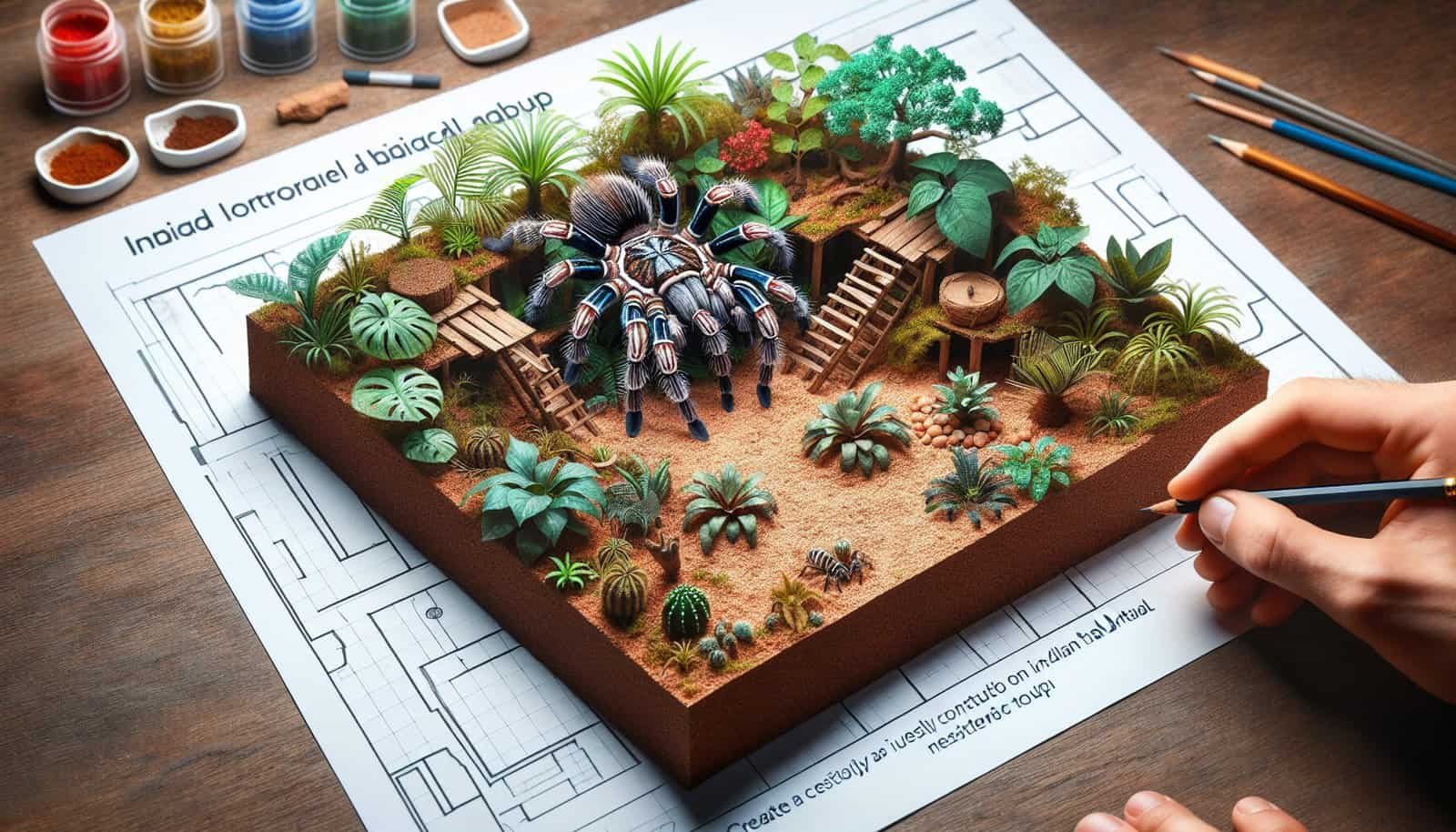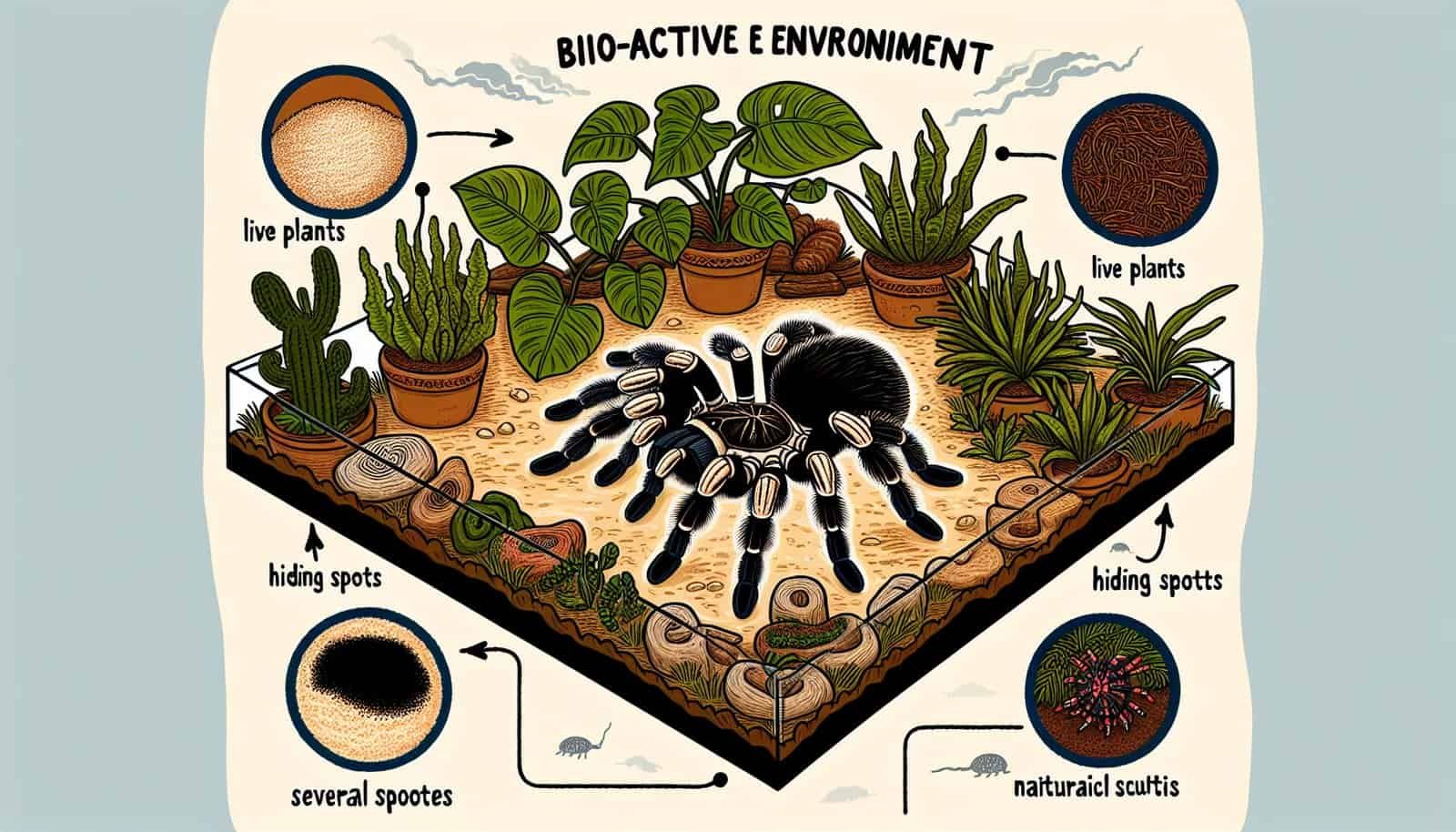If you’re a tarantula enthusiast looking to create the perfect habitat for your Indian Ornamental Tarantula, then you’ve come to the right place! In this article, we will explore the exciting world of bioactive setups and how they can benefit your tarantula’s health and overall well-being. From substrate choices to plant selection, we’ll guide you through the step-by-step process of creating an environment that closely mimics the Indian Ornamental Tarantula’s natural habitat, ensuring a happy and thriving pet. So, without further ado, let’s get started on this exciting journey!

Choosing the Right Terrarium
Size and Dimensions
When choosing a terrarium for your Indian ornamental tarantula, it is essential to consider the size and dimensions that will provide ample space for your pet to thrive. As a general rule of thumb, the terrarium should be at least three times the leg span of your tarantula to ensure it has enough room to move around comfortably. A larger terrarium will also allow for the addition of various features and hiding spots, creating a more stimulating environment for your pet.
Material and Features
The material of the terrarium plays a crucial role in creating a suitable habitat for your Indian ornamental tarantula. Opt for terrariums made of glass or plastic, as they provide excellent visibility and are easy to clean. Additionally, ensure that the terrarium has a secure lid to prevent any escapes.
Consider choosing a terrarium with features such as ventilation holes or mesh screens to facilitate proper air circulation. These features are essential in maintaining the right temperature and humidity levels within the enclosure.
Setting Up the Substrate
Layering the Substrate
Properly layering the substrate in your Indian ornamental tarantula’s terrarium is crucial for its overall well-being. Begin by adding a base layer of a drainage material, such as stones or activated charcoal, to improve aeration and prevent waterlogging.
On top of the base layer, create a layer of substrate that mimics the tarantula’s natural habitat. A combination of organic soil, coconut coir, and leaf litter works well to provide a suitable substrate for burrowing and maintaining humidity levels.
Choosing the Right Substrate Materials
When selecting substrate materials for your tarantula’s terrarium, it is important to choose ones that are safe and natural. Avoid using chemically treated or fertilized soils, as they can be harmful to your pet. Organic soil, coconut coir, and leaf litter are excellent choices, as they closely resemble the natural environment of the Indian ornamental tarantula.
Moisture and Humidity Control
Indian ornamental tarantulas require a relatively high level of humidity to thrive. To maintain suitable humidity levels, mist the terrarium with water regularly. Additionally, consider placing a small water dish in the enclosure to provide a source of drinking water and help maintain humidity.
Providing Hiding Spaces
Natural Hiding Places
Creating natural hiding places within the terrarium is vital for the mental and physical well-being of your Indian ornamental tarantula. Add various objects such as driftwood, rocks, and plant foliage to mimic the tarantula’s natural habitat. These natural hiding places will provide your pet with a sense of security and stimulate its natural behaviors.
Artificial Hiding Places
In addition to natural hiding places, consider incorporating artificial hiding places such as hollow logs, hide boxes, or commercial tarantula shelters. These structures offer additional hiding options and can be placed strategically throughout the terrarium to encourage exploration and provide your tarantula with different hiding spots.
Adding Climbing Structures
Branches and Cork Bark
Indian ornamental tarantulas are agile climbers, and providing them with suitable climbing structures is essential for their well-being. Branches and cork bark can be placed vertically or horizontally within the terrarium, allowing your tarantula to climb and explore its environment. Ensure that the branches and cork bark are securely positioned to avoid any potential accidents.
Artificial Climbing Structures
If natural climbing structures are not readily available, consider using artificial climbing structures such as resin logs or plastic plants. These can be easily positioned within the terrarium and offer your tarantula alternative climbing options.

Creating a Water Source
Water Dish
Providing a water dish within your Indian ornamental tarantula’s terrarium is essential for its hydration needs. Choose a shallow dish that is easily accessible for your pet and fill it with clean, chlorine-free water. Ensure that the dish is regularly cleaned and refilled to maintain proper hygiene.
Misting and Spraying
In addition to a water dish, it is important to create a moisture-rich environment for your tarantula. Regularly misting the terrarium with water replicates the natural humidity levels of the tarantula’s habitat. Use a spray bottle to mist the terrarium walls and substrate, taking care not to directly spray your pet.
Maintaining the Right Temperature and Humidity
Temperature Control
Maintaining the correct temperature within the terrarium is crucial for the well-being of your Indian ornamental tarantula. The ideal temperature range for this species is between 75 to 85 degrees Fahrenheit (24 to 29 degrees Celsius). Use a suitable reptile heating pad or heating lamp to maintain a consistent temperature throughout the enclosure. It is important to regularly monitor the temperature and make any necessary adjustments to ensure your tarantula’s comfort.
Humidity Control
Indian ornamental tarantulas thrive in humid environments. To maintain the required humidity levels, mist the terrarium regularly and monitor the humidity using a hygrometer. If the humidity drops below the recommended range of 70 to 80%, consider increasing misting frequency or adjust ventilation to retain moisture within the enclosure.

Choosing Suitable Lighting
Natural Lighting
Indian ornamental tarantulas do not require intense or direct lighting. They are predominantly nocturnal and prefer dimly lit environments. Place the terrarium away from direct sunlight, as excessive exposure may increase temperature and humidity levels beyond the tarantula’s comfort zone.
Artificial Lighting
While natural lighting is usually sufficient, you may opt to provide some ambient lighting to enhance visibility within the terrarium. Consider low-wattage LED lights or UVB bulbs to create a subtle and natural-looking illumination. Avoid using bright or harsh lights, as they may stress your tarantula.
Feeding and Nutrition
Appropriate Prey Size
When it comes to feeding your Indian ornamental tarantula, it is essential to offer appropriately sized prey. Tarantulas are opportunistic feeders and will eat a variety of live prey, such as crickets, roaches, and mealworms. The prey should be no larger than the tarantula’s body length. Feeding the correct prey size ensures your tarantula can safely consume its food without risk of injury.
Supplementing with Calcium and Vitamins
To ensure your Indian ornamental tarantula receives adequate nutrition, consider supplementing its diet with calcium and vitamin supplements. Dusting the prey with a reptile-specific calcium powder or multivitamin powder before feeding can help provide essential nutrients for your pet’s overall health. However, moderation is key, and it is important not to over-supplement.

Monitoring and Maintenance
Regular Cleaning and Replenishing
Maintaining a clean terrarium is crucial for your Indian ornamental tarantula’s health. Regularly remove any uneaten prey, shed skin, or waste to prevent bacterial growth and odors. Additionally, replenish the substrate and replace any soiled or moldy materials to maintain a clean and hygienic environment.
Observing Health and Behavior
Closely observing your tarantula’s health and behavior is vital in detecting any potential issues. Regularly check for signs of illness or injury, such as changes in appetite, abnormal behavior, or signs of stress. Erratic movements or excessive hair flicking, for example, may indicate a stressed tarantula. Promptly address any concerns by consulting a veterinarian with experience in exotic arachnid care.
Handling with Care
While Indian ornamental tarantulas can be fascinating to observe, it is important to remember that they are delicate creatures. Avoid handling your tarantula unless necessary, as they may become stressed or prone to falls. If handling is required, ensure you have proper guidance and experience, as well as a suitable container to safely transfer or transport your tarantula.
Ensuring Safety
Escape Prevention
Preventing escape is crucial when keeping any pet, and Indian ornamental tarantulas are no exception. Ensure that the terrarium lid is secure and tightly fitted to prevent your tarantula from escaping. Regularly inspect the enclosure for any gaps or openings that may allow your tarantula to squeeze through. Additionally, keep the terrarium in a space where it is less likely to get knocked or bumped into accidentally.
Securing Terrarium Accessories
When adding various decorative or functional accessories to the terrarium, it is important to securely fasten or position them to prevent any accidents or injuries. Ensure that branches, cork bark, or artificial climbing structures are stable and will not shift or fall, potentially crushing or harming your tarantula. Always prioritize your pet’s safety when arranging the terrarium.
Creating a bioactive setup for your Indian ornamental tarantula involves careful consideration of the terrarium, substrate, hiding spaces, climbing structures, water source, temperature and humidity control, lighting, feeding, monitoring, maintenance, and ensuring safety precautions. By following these guidelines and paying attention to your tarantula’s specific needs, you can create a thriving and stimulating environment for your impressive pet. Remember to continuously monitor and adapt to your tarantula’s preferences and behaviors to provide the best possible care.

